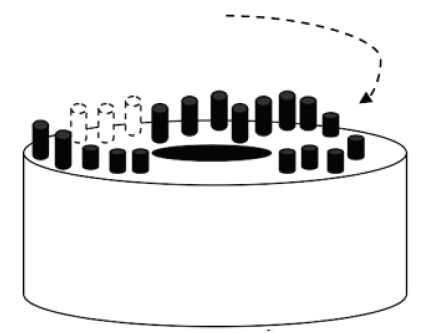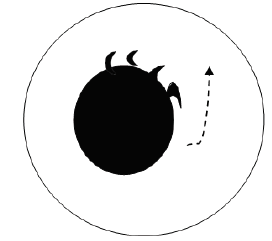- Submissions

Full Text
Aspects in Mining & Mineral Science
Clustering and Synchronization in Spin Combustion
Igor A Filimonov*
Merzhanov Institute of Structural Macrokinetics and Materials Science RAS, Russia
*Corresponding author: Igor A Filimonov, Merzhanov Institute of Structural Macrokinetics and Materials Science RAS, Chernogolovka Moscow Region 142432, Russia
Submission: February 22, 2021;Published: March 01, 2021

ISSN 2578-0255Volume6 Issue2
Opinion
The scientific community interest to phenomena of synchronization in wildlife is associated, first of all, with a desire to describe the functioning of living cells. Nevertheless, it is clear that the number of objects of unanimated nature significantly exceeds the number of living organisms. Moreover, each living organism or a cell is built from unanimated elements of the periodic table. Therefore, each manifestation of synchronization in non-living systems is more exciting and interesting than the conventional synchronization inherent to living cells or viruses, both in terms of the emergence of the terrestrial life on and in terms of the greatest coverage of natural phenomena and processes (Figure 1-3). Spin combustion has been studied and detected extensively in different systems. From the gas- solid systems similar to [1] up to termites [2,3]. Both experimental [1-3] and numerical data [4-6,7] concerning this phenomenon have been obtained up today. Nevertheless, both the volumes of these data were analyzed separately in fact. Therefore, some important peculiarities of spin combustion have been actually lost and need to be pointed out especially now. I am only going to remind again results [1] to a reader, and to conduct here their joint analysis with calculations [4-7] in terms of modern achievements of the theory of complex systems [8]. The analysis allows me to argue that spin combustion itself behaves like complex systems. In particular, when spin combustion is initiated, the clustering effect which is schematically illustrated in (Figure 1). happens as a rule already at the earliest stage of spin ignition (see also data [9]). clustering at first not seen in an early work [10], was revealed later in 3-dimensional modeling [11].
Figure 1: Single-headed spin combustion ignition. Side view of the recalculated results [1] at 0< t<≈ ta (disk-shaped sample) schematically.

Figure 2: Clustering of a single-headed spin into double-headed or triple-headed spin combustion modes consistently at t=tb≈>1.29 ta. Top view of the recalculated results [1] schematically.

Figure 3: Formation of a saw-tooth structure, STS, (was observed numerically only [7]) Top view of STS schematically at t=tc>≈2.58 ta.

Conclusion
One may conclude that spin combustion may be attributed to complex systems.
Acknowledgment
This work was carried out in the framework of governmental program for ISMAN (topic no. 44.1).
References
- Vadchenko SG, Filimonov IA (1999) Wave combustion modes of hafnium in nitrogen. Comb Explos & Shock Waves 35(2): 155-161.
- Strunina AG, Dvoryankin AV (1981) Effect of heat factors on regularities of the unstable combustion of termite systems. Dokl Akad Nauk SSSR 260(5): 1185-1188.
- Dvoryankin AV, Strunina AG, Merzhanov AG (1982) Trends in the spin combustion of termites. Combustion, Explosion and Shock Waves 18: 134-139.
- Novozhilov BV (1993) The theory of surface spin combustion. Pure & Appl Chem 65(2): 309-316.
- Novozhilov BV (1993) Quasistationary theory of spiral combustion regime. Internat J SHS 2(3): 207-213.
- Filimonov IA, Kidin NI, Mukasyan AS (2000) The effect of infiltration and reactant gas pressure on spin combustion in a gas-solid system. Proc of the Combustion Institute 28(1): 1421-1429.
- Markov AA, Filimonov IA (2021) Papers in print.
- Manrubia SC, Mikhailov AS, Zanette DH (2004) Emergence of dynamical order: synchronization phenomena in complex systems. World Scientific Publishing Co Pt Ltd p. 359.
- Rubtsov NM, Seplyarskii BS, Alymov MI (2021) Initiation and flame propagation in combustion of gases and pyrophoric metal nanostructures, springer. Fluid Mechanics and its Applications (123).
- Ivleva TP, Merzhanov AG, Shkadinskii KG (1980) Principles of the spin mode of Combustion front propagation. Combustion and Explosion Physics 16(2): 3-10.
- Ivleva TP, Merganov AG, Shkadinskii KG (2000) Three-dimensional spinning waves of gasless combustion. Dokl Akad Nauk 371(6): 753-758.
© 2021 Igor A Filimonov. This is an open access article distributed under the terms of the Creative Commons Attribution License , which permits unrestricted use, distribution, and build upon your work non-commercially.
 a Creative Commons Attribution 4.0 International License. Based on a work at www.crimsonpublishers.com.
Best viewed in
a Creative Commons Attribution 4.0 International License. Based on a work at www.crimsonpublishers.com.
Best viewed in 







.jpg)






























 Editorial Board Registrations
Editorial Board Registrations Submit your Article
Submit your Article Refer a Friend
Refer a Friend Advertise With Us
Advertise With Us
.jpg)






.jpg)














.bmp)
.jpg)
.png)
.jpg)










.jpg)






.png)

.png)



.png)






